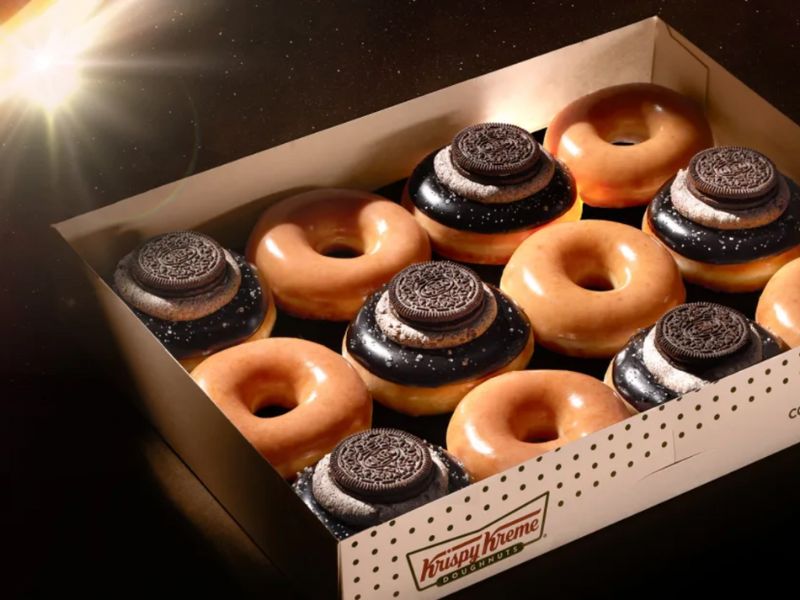Hey, all!
It’s been a wild two weeks. We signed our biggest client EVER, brought on two new team members, pitched an even bigger piece of business this week, and generally knocked it out the park for clients. The team is flying.
This week, we recap some of the campaigns we loved off the back of the solar eclipse, dive into how Dior is leveraging technology to increase e-commerce conversion, and highlight how the research industry has changed…for the better.
We have a few events on the horizon with the upcoming PRovoke North America Summit and Collision in June. Let us know if you’ll be around!
Oh, one SMALL CTA….help us hire! We’re still actively seeking a number of roles. We’ll love you forever if you refer us to some of your favs! Ok, ok fine…we already love you. See ya next time.
Becky & Greg
Having fun with trending events: How brands made the most of the recent solar eclipse

Krispy Kreme’s Total Solar Eclipse specialty dozen. Courtesy Krispy Kreme
TL;DR: Whether or not you were able to experience last Monday’s solar eclipse across North America, you may have experienced brands’ eclipse-themed offerings to celebrate the occasion. A few of note: Moon Pie’s solar eclipse survival kits, Krispy Kreme’s Oreo-covered donut, SunChips’ limited-time new flavor (available for free only during totality), Warby Parker’s ISO-certified free solar eclipse glasses, and our own client TouchTunes’ data on the popularity of Bonnie Tyler’s Total Eclipse of the Heart (a 1000% surge in plays).
Takeaway: When major cultural events and conversations are happening, you might benefit from asking whether or not your brand could be involved in a thoughtful, creative way. It makes a lot of sense for an eyewear brand like Warby Parker to offer up free solar eclipse glasses, introducing them to audiences that may not know about the brand and cement loyalty with their existing fanbase. Or, for a brand with timely data like TouchTunes to pull some relevant insights on the trend. When executed through an attention-grabbing or unique campaign, jumping on current events or cultural conversations can be a fun and relevant brand opportunity.
Consider:
- What cultural conversations are happening or about to happen? Does it make sense for your brand to take part?
- Equally important is knowing when not to take part in a cultural event. Make sure you’re aware of what’s going on in the zeitgeist, but hold strong what makes sense for your brand.
Positioning high-quality tech: How Christian Dior made virtual try-ons a luxury experience
TL;DR: Augmented reality (AR) has come a long way when it comes to helping businesses with physical products (that are typically seen in person before purchasing) evolve into the e-commerce space. Popularized by brands like Wayfair and Target for allowing users to imagine furniture in their homes, AR allows customers to visualize products in their spaces before committing to a purchase. Now, we’re seeing luxury clothing brands like Christian Dior using the tech as well in order to reach wider audiences and help convert buyers online, while still managing to maintain the allure of their elite reputation – something that may not always be the first thought when it comes to new tech like AR. Using virtual try-on (VTO) technology, the results of Dior’s AR campaign showed a 17% increase in respondents recognizing the brand as premium and a 36% lift in purchase intent.
Takeaway: While AR tools can be useful, the tech still has limitations when trying to replicate an in-person buying experience– colors can be off, the tech glitches, or it simply doesn’t look the same as it would in an in-person experience– leading to slower adoption by some brands (particularly those that want to maintain a feeling of a luxury shopping experience). But Dior’s campaign shows that those perceptions can be beaten and, with a robust virtual experience mirroring the luxury in-person experience, the conveniences of AR are proving they can support premium products. While tech innovations like AR or even generative AI tools aren’t going anywhere, they aren’t perfect yet, which sometimes leads to negative perceptions about their limitations. But that will change. Through carefully curated content and aligning with a modern, more responsive audience – like Dior did in their campaign – just about any brand can find a way into technological innovation.
Consider:
- What is your industry’s perception of tech tools like AR or AI? What are typical concerns or negative sentiments you’ve heard about it within your industry?
- If you’re a high-end brand or work with a premium product, what does innovation look like to you? How can you get ahead of the game while maintaining your brand?
Using your users: What the future of user research looks like
TL;DR: User research company Maze surveyed over 1,200 product professionals in January 2024 to understand current trends in the user research landscape. Their report summarized the data into three key trends: demand for user research is growing, research democratization empowers stronger decision-making, and new technology allows product teams to scale research.
Takeaway: In the study, user research was shown to have an 85% impact on improving product usability, 58% impact on improved customer satisfaction, and 44% impact on improved customer engagement. That’s a tremendous amount of cross-functional benefits with just one action. Furthermore, more than 60% of respondents use AI to analyze user research data – meaning you don’t have to invest massive amounts of team effort to glean insights from user data. By investing in user research initiatives like focus groups, surveys, and concept testing or even async web tools like Hotjar or UserTesting, you can get a quick read of how your brand is resonating with audiences and where you should be allocating your resources for maximum impact.
Consider:
- What do you want to know about your users? What could you ask them?
- In lieu of involved initiatives like hosting focus groups or usability testing, what tools could you use to automate user research?



